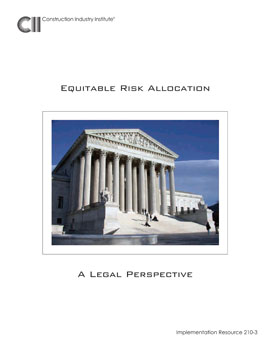
Equitable Risk Allocation: A Legal Perspective
When allocating construction risks, appropriate allocation is often not achieved due to the inferior bargaining position held by lower-tier parties. Beyond this dilemma, the most appropriate and equitable allocation of a particular risk can vary from project to project depending on factors such as the type of risk, work, and contract. As a result, no single, appropriate allocation exists for a given construction risk for all projects. Unfortunately, arriving at a conclusive agreement between contracting parties as to the most appropriate allocation of a given construction risk for a specific project can be a cumbersome, albeit crucial, task.
Due to the problems associated with determining appropriate risk allocation between contracting parties, the Construction Industry Institute (CII) formed the Contracting to Appropriately Allocate Risk Research Team in an effort to encourage risk assessment and allocation in a compromising and educated manner, recognizing the unique circumstances of each specific project. By involving both the owner and the contractor in the risk allocation process, which should begin early in the project life cycle, both parties can avoid the increased costs associated with inappropriate risk allocation. To aid in this process, the research team developed the Two-Party Risk Assessment and Allocation Model, which encourages contracting parties to compromise during the risk allocation process.
This publication is meant to accompany the Two-Party Risk Assessment and Allocation Model by providing useful legal perspective references regarding both contract language and legal research. This book looks at the top 14 risks, identified as the “hot-button” risks, which are listed below in order of the most to the least frequently allocated in an inappropriate manner:
IR210-3, Equitable Risk Allocation: A Legal Perspective
This is a companion publication to IR210-2, and should be used in conjunction with IR210-2. Significant contents include listing of “hot button risks” (risks most frequently allocated inaprropriately), list of general risk allocation principles and legal risk allocation principles, and a contract language table for each of the “hot button risks.” IR210-3 also includes a legal issues and considerations flow chart for each risk. These charts help minimize the confusion and ambiguities surrounding the allocation of each risk.

